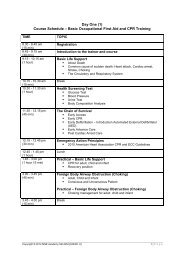Eric lippert - Amazon Web Services
Eric lippert - Amazon Web Services
Eric lippert - Amazon Web Services
Create successful ePaper yourself
Turn your PDF publications into a flip-book with our unique Google optimized e-Paper software.
<br />
<br />
<br />
<br />
<br />
<br />
<br />
<br />
<br />
In ‘nav.html’ is an example of how Knockout.js is leveraged<br />
for rich model binding:<br />
<br />
<br />
<br />
Hot Towel SPA<br />
<br />
<br />
<br />
<br />
<br />
<br />
<br />
<br />
<br />
<br />
<br />
activate: activate,<br />
title: ‘Home View’<br />
};<br />
return vm;<br />
function activate() {<br />
logger.log(‘Home View Activated’, null, ‘home’, true);<br />
return true;<br />
}<br />
});<br />
<strong>Services</strong><br />
All the application specific services are found in the<br />
‘App/services’ folder. HotTowel comes standard with the<br />
‘logger.js’ service responsible for logging messages and also<br />
displaying it on the screen as toast notifications. The ‘services’<br />
folder is the ideal place to put logic like data-retrieval for<br />
instance.<br />
Running the template<br />
Out of the box, HotTowel is ready to run. Just hit F5 and you’ll<br />
get:<br />
ViewModels<br />
The application’s viewmodels are found in the ‘App/viewmodels’<br />
folder. Inside the ‘shell.js’, ‘home.js’ and ‘details.js’ are<br />
properties and functions bound to ‘shell.html’, ‘home.html’ and<br />
‘details.html’ respectively. For example, let’s explore ‘home.html’:<br />
<br />
<br />
<br />
And ‘home.js’:<br />
define([‘services/logger’], function (logger) {<br />
var vm = {<br />
Hands on example<br />
Let’s say you want to create a page called ‘Tweets’ that shows<br />
the latest tweets from DotNetCurry.<br />
Implement the service<br />
We will need some kind of service that will be responsible<br />
for retrieving tweets from Twitter, given a certain search term.<br />
Right-click the ‘App/services’ folder and add a new JavaScript file<br />
called ‘twitter.js’ with the following contents:<br />
DNcmagazine www.dotnetcurry.com | 27

















